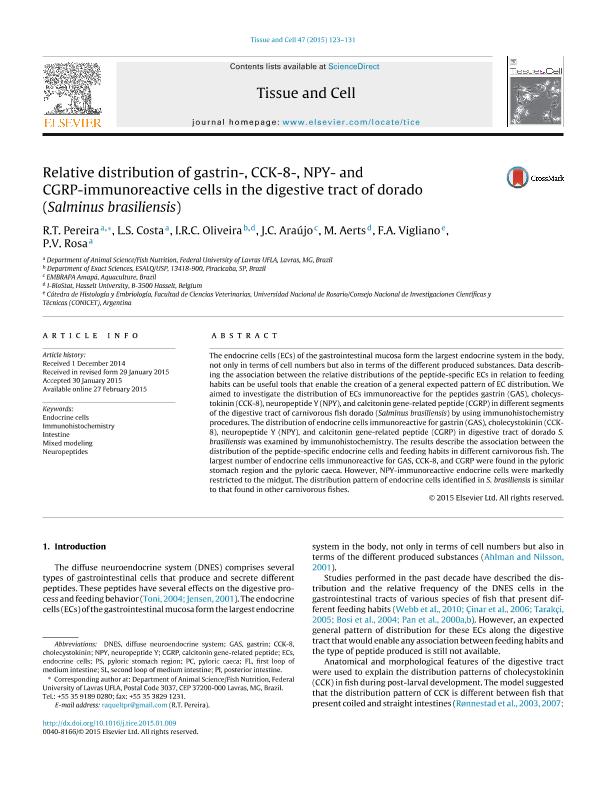Mostrar el registro sencillo del ítem
dc.contributor.author
Pereira, R. T.
dc.contributor.author
Costa, L. S.
dc.contributor.author
Oliveira, I. R. C.
dc.contributor.author
Araújo, J. C.
dc.contributor.author
Aerts, M.
dc.contributor.author
Vigliano, Fabricio Andrés

dc.contributor.author
Rosa, P. V.
dc.date.available
2017-03-03T21:06:26Z
dc.date.issued
2015-04
dc.identifier.citation
Pereira, R. T.; Costa, L. S.; Oliveira, I. R. C.; Araújo, J. C.; Aerts, M.; et al.; Relative distribution of gastrin-, CCK-8-, NPY- and CGRP-immunoreactive cells in the digestive tract of dorado (Salminus brasiliensis); Elsevier; Tissue & Cell; 47; 2; 4-2015; 123-131
dc.identifier.issn
0040-8166
dc.identifier.uri
http://hdl.handle.net/11336/13528
dc.description.abstract
The endocrine cells (ECs) of the gastrointestinal mucosa form the largest endocrine system in the body, not only in terms of cell numbers but also in terms of the different produced substances. Data describing the association between the relative distributions of the peptide-specific ECs in relation to feeding habits can be useful tools that enable the creation of a general expected pattern of EC distribution. We aimed to investigate the distribution of ECs immunoreactive for the peptides gastrin (GAS), cholecystokinin (CCK-8), neuropeptide Y (NPY), and calcitonin gene-related peptide (CGRP) in different segments of the digestive tract of carnivorous fish dorado (Salminus brasiliensis) by using immunohistochemistry procedures. The distribution of endocrine cells immunoreactive for gastrin (GAS), cholecystokinin (CCK-8), neuropeptide Y (NPY), and calcitonin gene-related peptide (CGRP) in digestive tract of dorado S. brasiliensis was examined by immunohistochemistry. The results describe the association between the distribution of the peptide-specific endocrine cells and feeding habits in different carnivorous fish. The largest number of endocrine cells immunoreactive for GAS, CCK-8, and CGRP were found in the pyloric stomach region and the pyloric caeca. However, NPY-immunoreactive endocrine cells were markedly restricted to the midgut. The distribution pattern of endocrine cells identified in S. brasiliensis is similar to that found in other carnivorous fishes.
dc.format
application/pdf
dc.language.iso
eng
dc.publisher
Elsevier

dc.rights
info:eu-repo/semantics/openAccess
dc.rights.uri
https://creativecommons.org/licenses/by-nc-sa/2.5/ar/
dc.subject
Endocrine Cells
dc.subject
Immunohistochemistry
dc.subject
Intestine
dc.subject
Mixed Modeling
dc.subject
Neuropeptides
dc.subject.classification
Otras Ciencias Veterinarias

dc.subject.classification
Ciencias Veterinarias

dc.subject.classification
CIENCIAS AGRÍCOLAS

dc.title
Relative distribution of gastrin-, CCK-8-, NPY- and CGRP-immunoreactive cells in the digestive tract of dorado (Salminus brasiliensis)
dc.type
info:eu-repo/semantics/article
dc.type
info:ar-repo/semantics/artículo
dc.type
info:eu-repo/semantics/publishedVersion
dc.date.updated
2017-02-23T13:55:30Z
dc.journal.volume
47
dc.journal.number
2
dc.journal.pagination
123-131
dc.journal.pais
Países Bajos

dc.journal.ciudad
Amsterdam
dc.description.fil
Fil: Pereira, R. T.. Universidade Federal de Lavras; Brasil
dc.description.fil
Fil: Costa, L. S.. Universidade Federal de Lavras; Brasil
dc.description.fil
Fil: Oliveira, I. R. C.. Universidade Do Sao Paulo. Escola Sup D/agricultura Luiz de Queiroz Esalq; Brasil. Hasselt University; Bélgica
dc.description.fil
Fil: Araújo, J. C.. EMBRAPA Amapá; Brasil
dc.description.fil
Fil: Aerts, M.. Hasselt University; Bélgica
dc.description.fil
Fil: Vigliano, Fabricio Andrés. Universidad Nacional de Rosario. Facultad de Ciencias Veterinarias. Departamento de Ciencias Básicas. Cátedra de Histología y Embriología; Argentina. Consejo Nacional de Investigaciones Científicas y Técnicas; Argentina
dc.description.fil
Fil: Rosa, P. V.. Universidade Federal de Lavras; Brasil
dc.journal.title
Tissue & Cell

dc.relation.alternativeid
info:eu-repo/semantics/altIdentifier/doi/http://dx.doi.org/10.1016/j.tice.2015.01.009
dc.relation.alternativeid
info:eu-repo/semantics/altIdentifier/url/http://www.sciencedirect.com/science/article/pii/S004081661500018X
Archivos asociados
